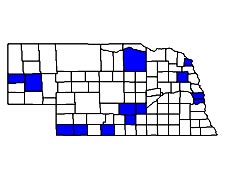
| Cicindela cursitans LeConte |
| Adult Length: 6.5 to 10 mm |
| Appearance: Adults of this species are very small and usually have a pattern of broken pale markings on the elytra. The ground color is usually brown to slightly coppery, but can occasionally be strongly greenish. In most specimens the marginal band may be continuous from the apical mark to the posthumeral mark, with a dot representing the end of the middle band, and in rare individuals the middle band may be complete. The humeral dot is lacking. This species is very similar to C. celeripes, but can readily be distinguished by the habitat in which they occur. Cicindela cursitans occurs in moist habitats, while C. celeripes occurs in upland grassland areas. |
| Similar Species: The only tiger beetle this is likely to be confused with is C. celeripes. These two species are very similar in size and appearance but this species differs from C. celeripes in that it typically has a continuous marginal band from the apical markings. The discovery of a current C. celeripes population in Nebraska would be a remarkable find. |
| Biology: This species inhabits moist clay and clay-sand soils, but can also be found on soils rich in organic material. Preferred habitats include ditches, wet meadows, moist grasslands, mudflats, upper reaches of shorelines, and possibly temporary streambeds. This species is most numerous in areas of relatively sparse vegetation, but it can be found in tall-grass prairies with minimal thatch buildup. Though adults may occur on sandy soils, larvae occur only in soils of small particle size, such as clay, clay-sand, or mucky soils. They may also occur on highly alkaline clay soils. Adults do not fly, but run rapidly, often hiding among vegetation when alarmed. They may easily be mistaken for small spiders, but do not hop like spiders, instead they run continuously. Adults can be very difficult to spot, but can be numerous once located. Highest numbers occur in moist ditches and other moist clay areas with somewhat sparse vegetation. |
| Adult Life History: Adults usually emerge in late June and early July, with peak numbers in mid-July. Adult activity declines rapidly by late July, and adults are scarce by early August. As in several other summer species, the peak activity period is variable, and occasionally adults may be numerous by mid-June. It is a summer species. |
| Larval Life History: Larvae occur in vertical burrows in moist clayey of mucky soils. Third instar burrows are usually about 10 to 15 cm in depth. The larval stage usually is completed in one year. Eggs are laid mostly in July and most larvae reach the third instar by early September. Larval activity resumes in spring and most larvae will pupate in late May and early June. The larvae are quite timid and nearly impossible to fish out with a grass blade. |
| Biogeography: This species likely occurs throughout most of Nebraska. It is likely overlooked because of its small size. It appears to be fairly common in wet meadows in the Platte River Valley. It should be looked for elsewhere, as it probably occurs in many areas from which it has not yet been recorded. In the North America it occurs in two geographical areas. It is known from the Dakotas, Nebraska, Kansas, Iowa, and western Minnesota, as well as Illinois, Missouri, the Ohio Valley states, Tennessee, Arkansas, Louisiana, Mississippi, and Alabama. A large distributional gap between the eastern and Great Plains populations as well as structural differences in the adults has caused speculation that this may consist of more than one species (Huber, pers. comm.). |




